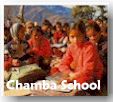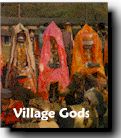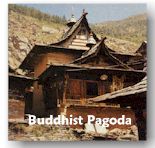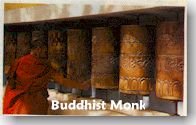
People
Most of the people in Himachal depend on agriculture for
livelihood. Many people derive their income from sheep,
goats, and other cattle. Ninety percent of the people live
in villages and small towns. Villages usually have terraced fileds and small two storey houses with
sloping roof. The villages are mostly self-contained with a
few shops to take care of basic necessities of life. Most
villages have a temple, where people congregate for worship.
In many parts of the Himachal the village Gods are carried
on palanquins to village fairs. On Dussehra the largest
congregation of village Gods takes place at Kullu.
have terraced fileds and small two storey houses with
sloping roof. The villages are mostly self-contained with a
few shops to take care of basic necessities of life. Most
villages have a temple, where people congregate for worship.
In many parts of the Himachal the village Gods are carried
on palanquins to village fairs. On Dussehra the largest
congregation of village Gods takes place at Kullu.
The folk songs of Himachal Pradesh are full of charm.
They are usually based on a  religious
or a romantic theme. People gather in a circle in village
fairs and dance to the tune of these songs. The dancing is
usually spontaneous during a village fair and is symbolic of
the peace and joy of the people. In general people of
Himachal Pradesh are honest, truthful, gentle, and good
humored. religious
or a romantic theme. People gather in a circle in village
fairs and dance to the tune of these songs. The dancing is
usually spontaneous during a village fair and is symbolic of
the peace and joy of the people. In general people of
Himachal Pradesh are honest, truthful, gentle, and good
humored.
Most of the children study at government run public
schools. There are many private schools at Shimla and other
parts of Himachal.
 TOP
TOP
Religion
 Most
of the people in Himachal are Hindus. There is a sizable
number of Buddhists who live in Himachal. Hinduism practiced in the areas of Himachal that
are closer to the northern plains is very similar to the
Hinduism practiced in the Most
of the people in Himachal are Hindus. There is a sizable
number of Buddhists who live in Himachal. Hinduism practiced in the areas of Himachal that
are closer to the northern plains is very similar to the
Hinduism practiced in the plains.
plains.
Upper hill areas have their own distinct flavor of
Hinduism. Their practice of religion combines the local
legends and beliefs with the larger Hindu beliefs. The
temple architecture has also been influenced by local
constraints such as availability or lack of availability of
certain construction materials. Most of the upper hill
temples are made of wood and more similar to Pagodas
in design.
 Most
of the people of Himachal who live in the areas that border
with China are Buddhist. There are many beautiful Buddhist
temples and pagodas in Himachal. Most
of the people of Himachal who live in the areas that border
with China are Buddhist. There are many beautiful Buddhist
temples and pagodas in Himachal.
 TOP
TOP
|

